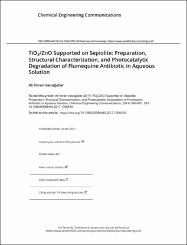TiO2/ZnO Supported on Sepiolite: Preparation, Structural Characterization, and Photocatalytic Degradation of Flumequine Antibiotic in Aqueous Solution
Abstract
In this study, TiO2, ZnO, TiO2/ZnO (Ti/Zn), and TiO2/ZnO/Sep (Ti/Zn/Sep) catalysts have been synthesized using sol-gel and chemical precipitation method. Their photocatalytic performances have been compared using Flumequine (FLQ) antibiotic. X-ray diffraction (XRD), Fourier transform infrared spectra (FTIR), scanning electron microscopy (SEM), N-2-adsorption, and the determination of a zero point charge has been used to characterize the synthesized catalysts. The degradation studies showed that the catalytic efficiency of Ti/Zn/Sep is higher than that for other catalysts. The operational parameters such as pH, initial FLQ concentration, and catalyst dosage were evaluated. UV-vis and high-resolution mass spectroscopy (HRMS) analyses were used to determine the degradation efficiency and products. ZnO played a major role in the FLQ degradation process, and sepiolite contributed to adsorption of FLQ on the catalyst surface enormously. The catalysts exhibited 11%, 23%, 63%, and 85% degradation efficiency for ZnO, TiO2, Ti/Zn, and Ti/Zn/Sep in the decomposition of FLQ, respectively.


















